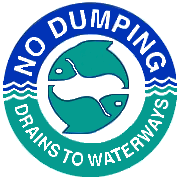Stormwater
Stormwater Pollution Prevention
Our Environmental Services staff implement permit compliance tasks and track stormwater regulations on behalf of the City of Rocklin. We document information on illegal discharge detection and elimination, street and storm drain cleaning, creek maintenance, stormwater and creek protection controls for development projects, business inspections, and public outreach, education and participation.
Stormwater pollution prevention is everyone’s responsibility, make sure that you are doing your part to contribute to Rocklin’s Pollution Solution!
The City of Rocklin’s Stormwater Program’s goals are to:
- Prevent stormwater pollution
- Protect and enhance water quality in creeks and wetlands
- Preserve beneficial uses of local waterways
- Comply with State and Federal regulations
Central Valley Regional Water Quality Board Website
State Water Resources Control Board Municipal Permits
Look for the Stormwater booth at these special events:
Earth Day
Woof Stock
Maker Faire
Hot Chili Cool Cars
To volunteer with the Stormwater program or to learn more information on volunteer opportunities within the city click on the link above!
Pollution Prevention Tips
Rocklin is a proud partner with the Our Water Our World (OWOW)
program which aims to raise awareness of the connection between
pesticide use and water quality. OWOW provides information to
consumers about integrated pest management (IPM) and less toxic
alternatives that are not causing water quality problems.

- Residential Pollution Prevention
- Household Hazardous Waste
- Pool Water Discharge
- Pet Waste Management
- Pressure Washing
- Integrated Pest Management
- Pollution Prevention for Kids
- Construction/Business Tracking
- Erase the Waste
- EPA Sollution to Pollution
- EPA Stormwater for Construction Industry
- MVC Wetlands in Your Neighborhood
- Placer County Stormwater Pollution Prevention for Food Service Industry
Tree Planting Guide
 Trees provide cooling shade, reduce air pollution,
provide wildlife habitat, and beautify our community but it is
important to plant a tree that is appropriate for its location.
The following Tree Guide was developed by PG&E for the
City of Rocklin and provides a list of recommended trees for
Rocklin.
Trees provide cooling shade, reduce air pollution,
provide wildlife habitat, and beautify our community but it is
important to plant a tree that is appropriate for its location.
The following Tree Guide was developed by PG&E for the
City of Rocklin and provides a list of recommended trees for
Rocklin.
Creek Water Testing Data
Data is collected at creeks throughout the City to monitor overall water quality and to follow trends over time. The parameters that are tested include pH, Temperature, Conductivity (or Oxidation-Reduction Potential), Turbidity, and Dissolved Oxygen.
Flood Zone FAQs
What Flood Zone am I in?
If you wish to make a determination for yourself, the Engineering Division makes the flood hazard maps available to the public for viewing, or go directly to: FEMA Flood Map Service Center for flood zone designation.
How is floodplain management related to insurance?
A community’s agreement to adopt and enforce floodplain management ordinances, particularly with respect to new construction, is an important element in making flood insurance available to home and business owners. Currently, more than 20,000 communities voluntarily adopt and enforce local floodplain management ordinances that provide flood loss reduction building standards for new and existing development.
How is the Federal Government involved?
The Federal Insurance and Mitigation Administration (FIMA), a component of the Federal Emergency Management Agency (FEMA) , manages the National Flood Insurance Program (NFIP). The three components of NFIP are:
- Flood Insurance
- Floodplain Management
- Flood Hazard Mapping
Is the City of Rocklin part of NFIP?
The City of Rocklin participates in the NFIP by adopting and enforcing floodplain management ordinances to reduce future flood damage. City of Rocklin Municipal Code Section 15.16 Flood Hazard Areas addresses floodplain management. In exchange for this voluntary participation, the NFIP makes federally-backed flood insurance available to homeowners, renters, and business owners in our community.
What are the benefits of floodplain management?
Flood insurance is designed to provide an alternative to disaster assistance to reduce the escalating costs of repairing damage to buildings and their contents caused by floods. Flood damage is reduced by nearly $1 billion a year through communities implementing sound floodplain management requirements and property owners purchasing flood insurance. Additionally, buildings constructed in compliance with NFIP building standards suffer approximately 80% less damage annually than those not built in compliance. Finally, every $3 paid in flood insurance claims saves $1 in disaster assistance payments.
In addition to providing flood insurance and reducing flood damages through floodplain management regulations, the NFIP identifies and maps the nation’s floodplains. Mapping flood hazards creates broad-based awareness of these hazards and provides the data needed for floodplain management programs and for actuarially rating new construction for flood insurance.
Elevation Certificates | who needs them and why
If your home or business is in a high-risk area, your insurance agent will likely need an Elevation Certificate to determine your flood insurance premium.
Floods mean rising water. Knowing your building’s elevation compared to the estimated height of floodwater helps determine your flood risk and the cost of your flood insurance.
An Elevation Certificate documents the elevation of your building for the floodplain managers enforcing local building ordinances and for insurance rating purposes.
Additional information can be found on FEMA’s website


